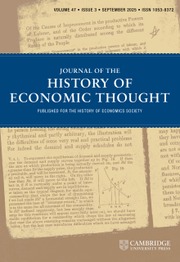Article contents
RELATIVE INCOME VS. PERMANENT INCOME: THE CRISIS OF THE THEORY OF THE SOCIAL SIGNIFICANCE OF CONSUMPTION
Published online by Cambridge University Press: 13 August 2012
Abstract
The investigation of aggregate consumption underwent a radical change in the USA during the 1940s and 1950s. Principles deriving from the American Institutionalist tradition attained their greatest popularity in Duesenberry’s formulation just before they were rapidly abandoned. This paper examines this turning point by comparing Duesenberry’s relative income hypothesis and Friedman’s permanent income hypothesis. This also makes it possible to identify a particular feature of Duesenberry’s analysis—its heterogeneity—which must be taken into consideration by those seeking a return to Institutionalist principles in the analysis of aggregate consumption.
- Type
- Research Articles
- Information
- Copyright
- Copyright © The History of Economics Society 2012
References
REFERENCES
- 5
- Cited by


